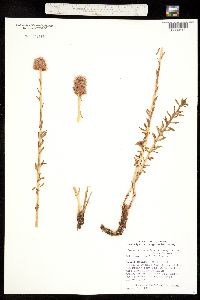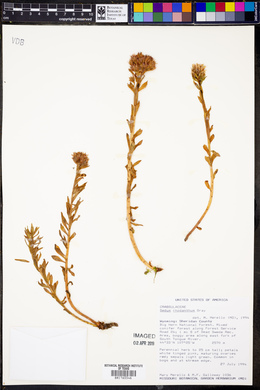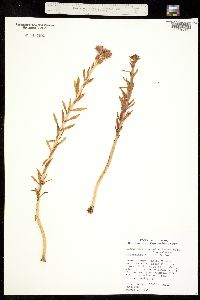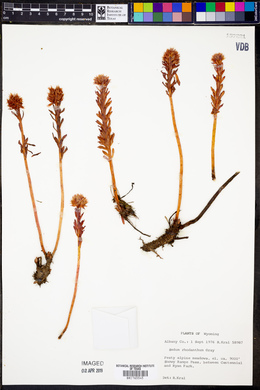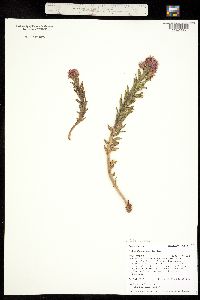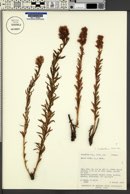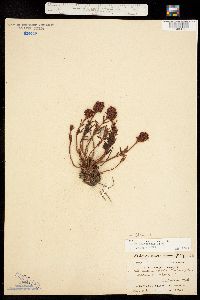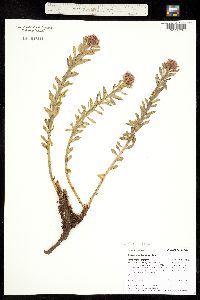Rhodiola rhodantha
|
|
|
|
Family: Crassulaceae
Queen's-Crown, more...redpod stonecrop
[Clementsia rhodantha (A. Gray) Rose, moreSedum rhodanthum A. Gray] |
Plants synoecious. Rootstock erect or decumbent, to 0.5-2 cm diam. Floral stems often persistent, 10-60 × 0.2-0.6 cm. Leaf blades green, not glaucous, linear-oblong to linear-oblanceolate, 1-4.5 × 0.2-0.7 cm, margins entire or few-toothed, apex mostly acute. Inflorescences spikelike or subcapitate, dense, to ca. 50-flowered, 1-3.5 cm diam. Pedicels mostly to 5 mm. Flowers bisexual, mostly 5-6-merous; sepals linear-lanceolate, 3-9 mm; petals nearly erect with tips outcurved, greenish or white to rose, linear-lanceolate to linear-oblanceolate, 6-13 mm, longer than stamens. Follicles 6-9 mm, beaks erect. Seeds short-tailed, oblong, 2 mm. 2n = 14. Flowering summer. Wet meadows, stream banks, rockfields, rock crevices; 2000-4200 m; Ariz., Colo., Mont., N.Mex., Utah, Wyo. Rhodiola rhodantha is placed in subg. Clementsia; the only other species in this subgenus is R. semenovii (Regel & Herder) Borissava, of Turkestan, with longer, narrower, entire leaves.
Plant: perennial herb; rootstock from stout taproot, to 1 dm high, 0.5-2 cm thick, often closely branching to form clumps, with close-set sessile brown ovate scale-leaves 4-10 mm long and often with persistent stem bases Leaves: alternate, subclasping, often toothed, broad and rather thin, those of rootstocks scale-like in ours INFLORESCENCE: FLORAL STEMS lateral, overtopping rootstocks, several, simple, erect, 1-6 dm tall, 2-6 mm thick, the leaves many, much longer that internodes, linear-oblong to oblanceolate, mostly acute, entire or few-toothed above, 1-3 cm long, 2-7 mm wide, with impressed midveins; inflorescence cymose or in ours spikelike or subcapitate, 1-7 cm high, 1-3.5 cm thick Flowers: mostly subsessile; sepals linear-lanceolate, purplish tipped, 3-9 mm long; petals linear-lanceolate to linear-oblanceolate, acute to acuminate, greenish or white to rose, 6-13 mm long; stamens 4-9 mm long, those opposite petals adnate 1-3 mm; pistils reddish, slender, 5-13 mm high, with slender styles Fruit: follicles, erect; SEEDS oblong, short-tailed, pale brown, faintly ribbed lengthwise, 2 mm long Misc: Wet meadows, streambanks, rockfields, rock crevices; 2800-3700 m (9000-12,300 ft); Jun-Sep REFERENCES: Moran, Reid. 1994. Bixaceae. J. Ariz. - Nev. Acad. Sci. Volume 27, 190-194. General: Perennial, 10-35 cm tall; stems several, erect to ascending, simple, stout, glabrous; caudex simple or branched; taproot stout. Leaves: Cauline, alternate, simple, narrowly oblong to oblanceolate, 1-3 cm long, 2-7 mm wide, fleshy, glabrous, margins entire to weakly toothed, becoming rolled under, apex acute; blades sessile. Flowers: Usually solitary and axillary; peduncles 1.5-2.5 cm long, often more than twice as long as the calyx, erect or reflexed in fruit; bracts awl-shaped to linear, minute; pedicels usually shorter than the peduncles; sepals oblong to broadly ovate, 7-9 mm long, rough with small, sharp projections or nodules on the midrib, otherwise glabrous; corolla broadly funnelform, 2.5-3.1 cm long, purple or pink, paler below; flowers July-September. Fruits: Follicles, usually 5, 5.5-8.5 mm long, erect with a diverging apex, pale brown to reddish; seeds oblong, short-tailed, pale brown, faintly ribbed. Ecology: Subalpine and alpine habitats, meadows, streambanks, rocky slopes, rock crevices; 2700-3700 m (9000-12300 ft); Apache (White Mountains) and Coconino (San Francisco Peaks) counties; north-central to southwestern U.S. Notes: Rhodiola rhodantha seeds exhibit physiological dormancy, and require dry storage or cold treatment to germinate. Editor: Springer et al. 2008 |

































